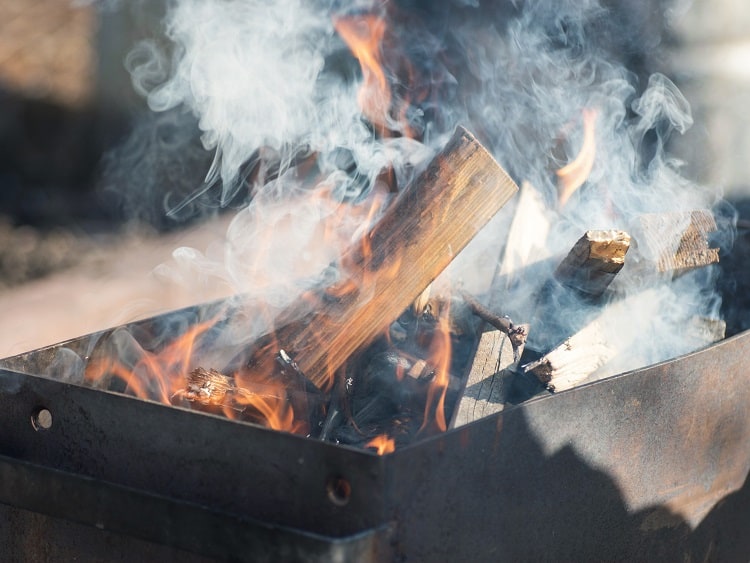
Nothing says “I want to go inside” more than a face full of smoke!
Fire pit smoke is a nuisance, but luckily, if you want to reduce smoke from your fire pit, that can easily be fixed by using the tips below.
Why Is My Fire Pit Smoking So Much?
First off, you need to understand why, before getting to the ‘how to fix it’ part of this article. Typically, you’re using the wrong or insufficiently seasoned wood, or there’s excess debris in or around the fire. This causes it to not burn well enough. Let’s start by looking at your wood.
The Best Wood for a Smoke-Free Bonfire
Simply said, a well-seasoned or kiln-dried hardwood like oak, hickory, ash, or cherry that’s been cut and split, is your best bet. There are others too. This is not an exhaustive list.
Why? Hardwoods are denser than your typical softwoods (pine, fir, cedar, for example) and, thus, contain more wood fibers that burn longer and hotter. This makes these the best low-smoke firewoods for fire pits to reduce or eliminate smoke.
Apart from the type of wood, it needs to be ‘seasoned’ or ‘kiln-dried.’
What Is ‘Seasoned’ or ‘kiln-dried’ Firewood?

Seasoned firewood typically refers to ‘green,’ or ‘fresh cut,’ firewood that has been split, stacked, and allowed to air dry outdoors for anywhere from 6 months to several years. The firewood is only seasoned after it is dried and reached a specific moisture content.
Most woods take anywhere from 1-3 years to dry, depending on the type of wood. The goal is for the wood to reach a moisture content of less than 20-30%.
Kiln-dried firewood is similar in that instead of allowing the wood to air-dry, a giant oven is used to heat the wood, thus removing the moisture content. The process typically takes anywhere from a few hours to several days, depending on the type of wood.
Kiln-dried firewood usually reaches a moisture content below 25%.
For the purpose of building a backyard fire, the marginal benefit of using kiln-dried or seasoned wood over the other is negligible. To keep your fire smoke-free, ensure your wood is dry enough (you can check with an inexpensive moisture meter), and keep it dry before using.
If the moisture content of your wood is high, as in greater than 30-40%, you have ‘green wood’ on your hands. This simply means the wood is fresh and has too much moisture for burning or any other purposes. You’ll want to let it sit out, above ground, but sheltered from the rain. This will allow the moisture to naturally leave the wood.
Avoid Using Softwoods
The above is said with a caveat, softwoods are good for starting fires. However, once the fire is going, throw your hardwoods on top so you can sit and relax for a bit.
Softwoods like pine, redwood, spruce, or really any evergreens, have a higher sap content and are less dense than hardwoods. With less density, it allows them to catch fire more quickly, but they only last for a short time in comparison.
Softwoods are preferred by some people because they produce the characteristic crackling noise heard on TV and in movies. Because of the wood’s high sap and resin content, this is released as excessive smoke that will create an unpleasant environment.
Create Proper Airflow in your Fire
Part of the chemical reaction needed to make a good fire is enough air or oxygen. Without enough air, the fire will not burn efficiently or may only smolder until it dies out. The problem is this is not always evident after the fire has started.
One tell-tale sign of an insufficient supply of oxygen is excessive smoke. Smoke from any fire is the incomplete burning of particles or chemicals that are released back into the air. For firewood, this is excess carbon that should be burned to produce a warmer fire.
Keep Your Fire Pit Clean
First and foremost, clean out your fire pit before starting any new fire. Use a coal shovel or shop vac to remove any leftover ashes or chunks of wood from the previous bonfire. You can use these remaining ashes to add carbon to your garden or compost pile, or simply dump them in the trash.
Use the Right Bonfire Structure
Asking someone whether they prefer a tee-pee or log cabin is like asking someone whether they prefer their ketchup on the side or all over their fries. There’s no right answer, nor is there a wrong one. However, in our opinion, what we have found most successful is using the log cabin style then, migrating to the tee-pee style as the fire builds up.
The log cabin structure provides airflow across all logs and allows you to place your kindling directly in the center where it can access oxygen sufficiently from top to bottom. As the fire grows, add logs to the 4 sides in a tee-pee style, and continue adding until the fire has reached your desired level.
6 Tips for Reducing Smoke in your Fire Pit

Don’t Put Anything Other Than Good Wood in There
As mentioned earlier in this article, it is okay to start off with softwood to get the fire going. However, once the fire has started, you will want to continue using thoroughly seasoned and dry hardwood like oak.
Do not let your friends or family throw trash, cans, or other debris into the fire. It might be fun to watch burn, but it’ll produce a nasty smell, clog the airflow, and ultimately be a hassle for you to clean up later. Instead, keep a trash can nearby for people to throw their trash away.
Consider a Smokeless Fire Pit
No matter how well you follow the rest of these tips, your fire will still produce some smoke even though you are using smokeless firewood.
This is because air can never reach the bottom of the fire to provide a complete burn. If you’re willing to spend some money, a Solo Stove or Breeo is the way to go to reduce, and maybe even eliminate, fire pit smoke. These fire pits have been specially engineered to produce a double-burn, where the air is brought from the bottom, heated, and then utilized to efficiently burn all the energy coming from the log.
It may sound a little high tech, but the concept is really quite simple. Its stainless steel, the double-wall design uses heated air to create a secondary and very cool-looking burn.
Fire pit built for the backyard and beyond. Easily light up smokeless fires anywhere life takes you.
Available in Stainless Steel or Corten, both are corrosion resistant and give you the option to choose a look that matches your lifestyle.
Use Dry and Seasoned, or Kiln-dried Firewood
It doesn’t matter what kind of wood you have if it’s wet! Firewood that has been seasoned for a couple of years and kept out of the rain is your best bet. If you have access to kiln-dried firewood, that is even better, although you may be paying a premium for a lesser amount of wood.
Gas station firewood may be alright, but if it has rained recently, the wood will be damp and very hard to light. Finding a good firewood dealer usually isn’t hard for most people, and they will have their wood sheltered and dry.
Properly store your firewood. After you’ve bought a face cord, rick, truckload, or whatever amount of firewood, you need to properly store it. In short, keep the wood at least 6 inches off the ground, mostly sheltered from the rain, and adequate airflow on all 4 sides.
Even if you live in a residential area, there are plenty of cheap firewood storage options. If you’re not the most handy person, there are some extremely simple DIY firewood storage methods that cost less than $15-$20 to store your wood.
Keep Your Fire Pit Clean
Keeping your fire pit clean ensures you’ll have an easier time setting up the next fire. After the fire has completely gone out and cooled down, dump the pit into a safe area, or use a shop vac or shovel to clean out any remaining coals.
Your fire pit doesn’t have to be sparkling clean, but it needs to be free of the previous fire’s debris.
Use the Right Configuration
Whatever your style for creating a fire is, just ensure it has adequate airflow from all sides. You can use the tee-pee method, or the log cabin style to build a fire. However, in our experience, we’ve found a combination of both has worked out best in the long run.





